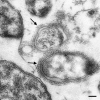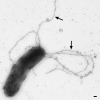Carrion's disease: more than a neglected disease
- PMID: 30909982
- PMCID: PMC6434794
- DOI: 10.1186/s13071-019-3390-2
Carrion's disease: more than a neglected disease
Abstract
Infections with Bartonella bacilliformis result in Carrion's disease in humans. In the first phase of infection, the pathogen causes a hemolytic fever ("Oroya fever") with case-fatality rates as high as ~90% in untreated patients, followed by a chronical phase resulting in angiogenic skin lesions ("verruga peruana"). Bartonella bacilliformis is endemic to South American Andean valleys and is transmitted via sand flies (Lutzomyia spp.). Humans are the only known reservoir for this old disease and therefore no animal infection model is available. In the present review, we provide the current knowledge on B. bacilliformis and its pathogenicity factors, vectors, possible unknown reservoirs, established and potential infection models and immunological aspects of the disease.
Keywords: Bartonella bacilliformis; Carrion’s disease; Lutzomyia; Neglected tropical disease; South America; Vector-borne disease.
Conflict of interest statement
The authors declare that they have no competing interests.
Figures







References
-
- Amano Y, Rumbea J, Knobloch J, Olson J, Kron M. Bartonellosis in Ecuador: serosurvey and current status of cutaneous verrucous disease. Am J Trop Med Hyg. 1997;57:174–179. - PubMed
-
- Maguina C, Garcia PJ, Gotuzzo E, Cordero L, Spach DH. Bartonellosis (Carrionʼs disease) in the modern era. Clinical Infect Dis. 2001;33:772–779. - PubMed
Publication types
MeSH terms
Grants and funding
LinkOut - more resources
Full Text Sources
Other Literature Sources
Miscellaneous

